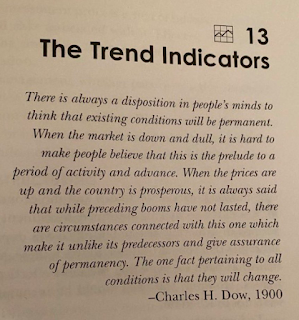***** denotes well-worth reading in full at source (even if excerpted extensively here)
Economic and Market Fare:
....... We’ve abandoned our reliance on speculative limits, but the combination of valuations and market internals remains central to our discipline. When neither is favorable, a “trap door” opens. That combination doesn’t require a market collapse, but it does permit one, because it brings risk-aversion into a market that’s not priced for risk. As I wrote at the 2000 bubble peak, “This is a lesson best learned before a crash rather than after one.” ........
Should we be teaching Neoclassical Economics to undergraduates?
“Because of this, we must teach it, but only to discredit it, make students aware of what is wrong, and what is disconnected from how markets operate. So, there is a distinction to be made between how markets do not follow the laws of neoclassical economics, and how the world is dominated by its practice: policy wonks, politicians, bankers and professors prefer to ‘rebuke the line for touching’. It is this wisdom and this distinction that we must teach our students.”
Vid of the Week:
Charts:
1:
...The Bullish Percent Index (BPI), developed by Abe Cohen in the 1950s, is a breadth indicator based on the number of stocks based on Point and Figure Buy signals. The indicator helps you know the market’s health and when it’s overbought or oversold.
— Bonnie Gortler (@Optiongirl) December 16, 2023
When the bullish percent… pic.twitter.com/J2Bw7QPqQf
...Financial professionals: 7.0%
— John P. Hussman, Ph.D. (@hussmanjp) December 16, 2023
Investors: 15.6%
They're both thoroughly out of their minds. #arithmetic https://t.co/UgBwnRRq8F pic.twitter.com/O4qnj552tE
...GARZARELLI: “.. No single historic episode is a perfect mirror for current events. But, as we wrote a year ago .. the inflationary period after WWII was a good comparison. Inflation peaked at 20.0% a bit over a year after WWII ended and fell into deflation within a few years.” pic.twitter.com/eL4yRp3Vjh
— Carl Quintanilla (@carlquintanilla) December 15, 2023
...That‘s a very good question indeed pic.twitter.com/Rd3gbHR8Um
— Michael A. Arouet (@MichaelAArouet) December 16, 2023
...The critical CPI Rent category is proving to be like an 18-wheeler riding its brakes down the mountain. It’s going down, there’s no doubt about that. But the lagged-by-design methodology means that it’s just not going to decelerate as fast as real-life rents are in every major… pic.twitter.com/9AVtwiWYRi
— Jay Parsons (@jayparsons) December 12, 2023
...🇺🇸 CPI... a core consensus view on inflation is that rent increases are cooling significantly. I have agreed but recent increases in the CPI is telling a slightly different story. And there are rent indicators that warn of CPI rents remaining problematic in 2024. Let's see... pic.twitter.com/mbsPaCPFXR
— Mikael Sarwe (@MikaelSarwe) December 12, 2023
...Each time inflation in China turned negative the global economy was in a recession: 2001, 2008-09, 2020... pic.twitter.com/ZOG5CDEryh
— Jeffrey Kleintop (@JeffreyKleintop) December 11, 2023
Valuation is “Perspective” NOT “Timing.” This chart DOES NOT say “Sell,” it says “When the time comes to sell, DO NOT hesitate.” Too many in the “time in the market” crowd will scoff at and ignore this message. But there is more to history than just "the market always goes up." pic.twitter.com/wsKFS5DqLF
— Jay Kaeppel (@jaykaeppel) December 11, 2023
(not just) for the ESG crowd:
It’s difficult to get a man to understand something when his salary depends on not understanding it.Upton Sinclair
This year's temperatures are giving new meaning to the phrase "off the charts"#StateofClimate
— World Meteorological Organization (@WMO) December 15, 2023
Graph of Sept-Nov temperatures from @NOAA pic.twitter.com/yaiJXawYpc
Geopolitical Fare:
Sci Fare:
















No comments:
Post a Comment